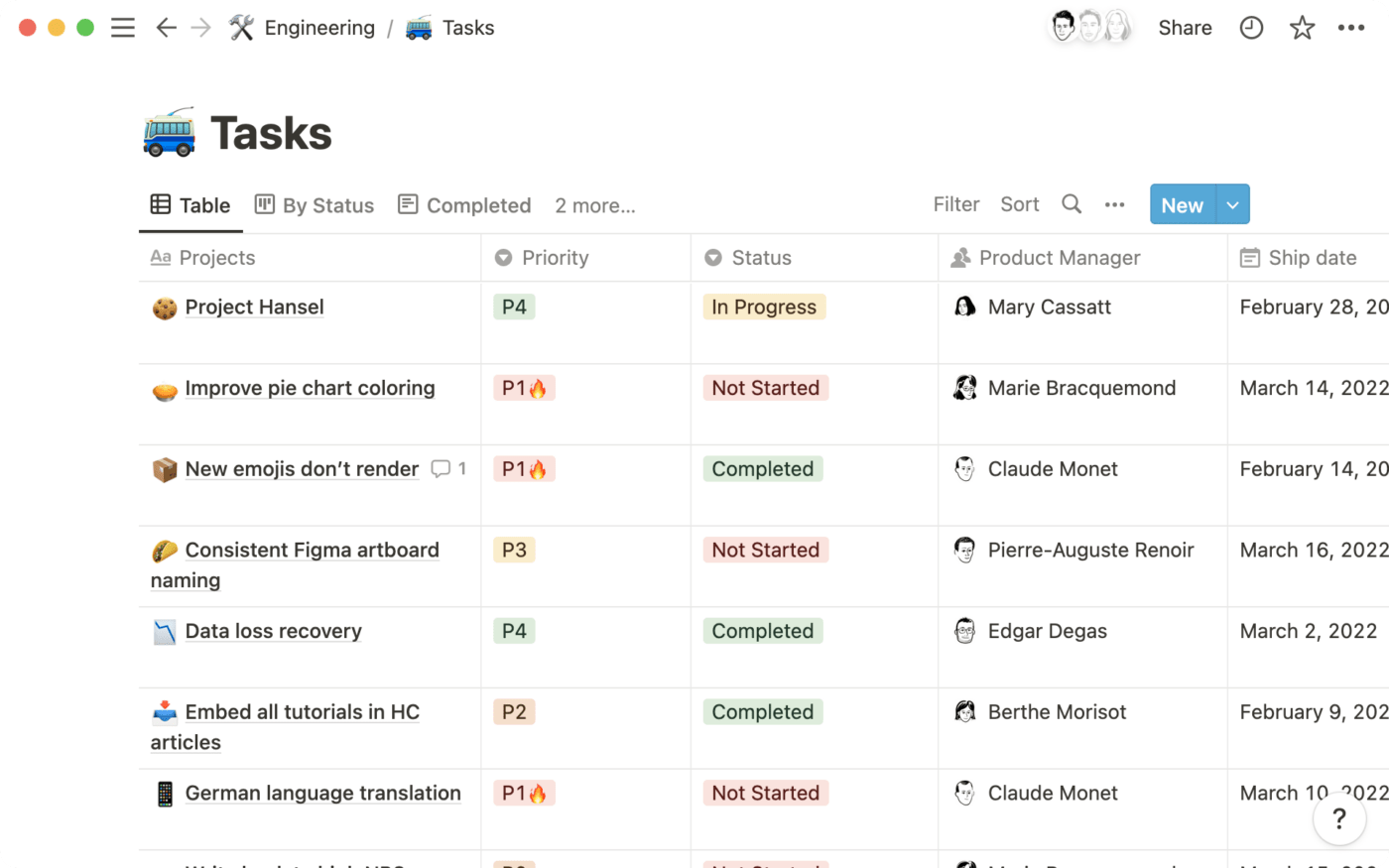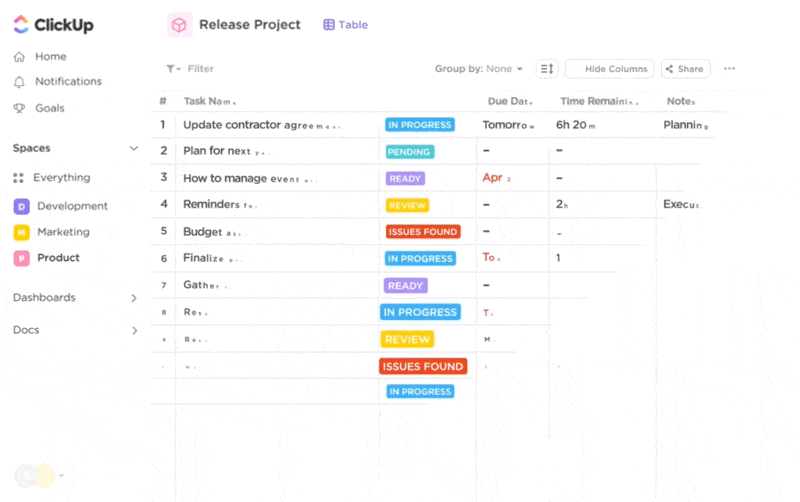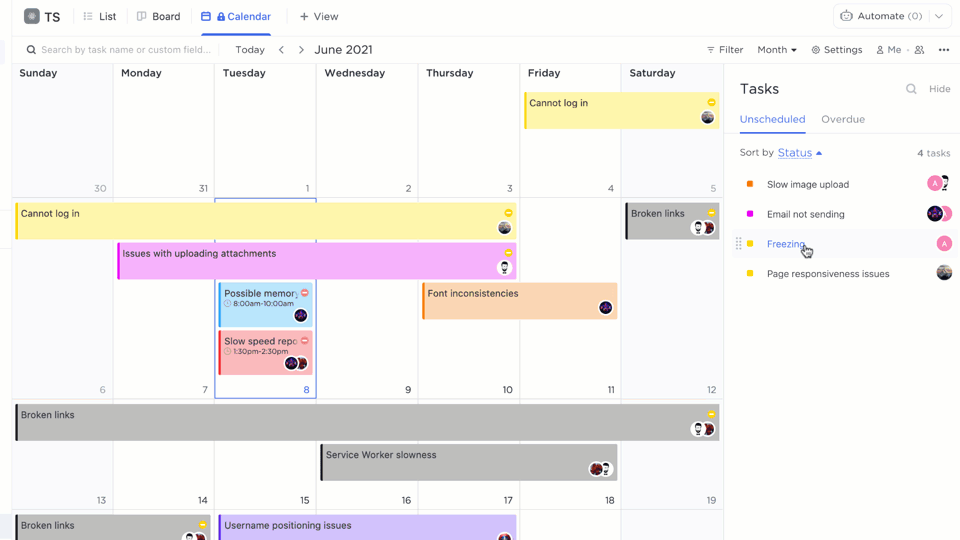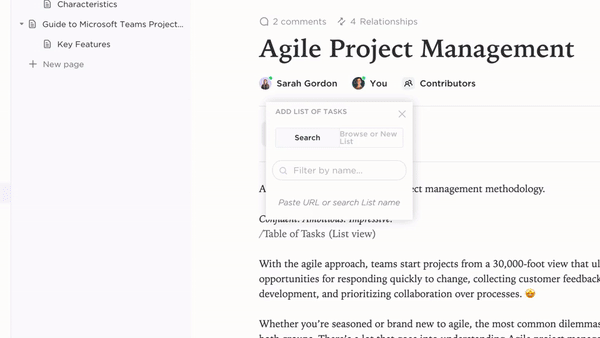

Modern life can be a bit of a tornado, and that’s where the need for top-notch task management tools comes in. These tools have become indispensable in both personal and professional spheres, thanks to their capabilities for supporting multitasking and productivity.
Motion and Notion were not exactly direct competitors in the software space when they were launched. Motion was initially geared toward providing scheduling features, while Notion was more of a knowledge management tool. But over time, both products have expanded their functionalities to cater to task and project management needs.
So, what makes these tools different (besides the first letters of their names)? 😜
If you’re stuck in the Notion vs. Motion dilemma, we’ll help you get unglued! Both platforms offer unique features that enhance workflows in different ways. Let’s do a step-by-step analysis to see which tool would make more sense to you.
What is Motion?

Motion is a revolutionary task manager, and we’re not exaggerating here! It’s more like a super-smart assistant on your phone or computer, combining calendar, to-do list, and project management functionalities, all while throwing in a touch of AI wizardry. 🧙
Motion’s AI and automation features are all about saving you time and hassle. It doesn’t just help you organize tasks and workflows—it takes the wheel, rearranging team schedules based on what’s most important and when someone would be available to do it. Forget about the stress of rescheduling missed or updated tasks, as Motion automatically re-inserts them into upcoming time slots.
Motion can be a blessing in terms of resolving scheduling and resource allocation conflicts, so you’re doing more and managing less!
Motion features
Let’s dive into the cool features that make this task management whiz even more amazing! 🪄
1. Automatic task manager
Motion’s task management system is all about efficiency—you can create tasks and sub-tasks in a snap, set due dates, and even slap on some handy reminders. Need to jot down important task info? Just add notes and attach files if necessary, keeping contextual data in one place. 📑
As a task manager, you’ll be able to loop in your teammates effortlessly and avoid information blockages due to siloed teams. Make them watchers or assignees for specific tasks to establish accountability. Get your team more organized by tagging tasks as:
- Free Task: Can be done at any time slot within an overarching deadline
- Busy Task: Has to be done at a specific time slot
- Fixed Task: Cannot be moved without pushing the deadline
You can use automation to streamline repetitive tasks. And, if a surprise meeting or a work emergency pops up, use one-click rescheduling to reorganize. Motion helps you visualize tasks in a list or Kanban board layout, giving you insights into various stages of your workflow.
2. Intelligent calendar
Once your tasks are lined up and neatly detailed, Motion’s AI steps in with its intelligent calendar. It automatically determines the best time and day to tackle each task, ensuring you and your team are ahead of those pesky deadlines!

Just set the working hours, and Motion calculates the arrangement of weekly tasks and meetings. The generated schedule ensures you get things done without burning the midnight oil. Plus, if you’re starting to overcommit, Motion’s got your back with handy warnings.
On top of all this, Motion plays well with your favorite calendars, like Google Calendar and Microsoft Outlook. You can easily sync and import your data. And the best part? This software color-codes your tasks so you can instantly spot the native ones (gray) and those imported from external calendars (other colors). 🗓️
3. Meeting assistant
Thanks to Motion’s AI Meeting Assistant, you have your own personal scheduler to stay on top of your day. With just a few clicks, you can invite attendees, pick the perfect time and date, and even specify the location. Other customizations include:
- Setting preferences for back-to-back meetings, mornings, or meeting-free days
- Capping daily meeting limits to avoid overcrowding
- Launching a personalized booking page to share your availability with others
The platform lets you create templates with unique lengths and schedules for different meeting types. Got any questions for your team? You can use custom settings to add survey or poll questions before the meeting—many Motion alternatives don’t have this feature!
Motion pricing
- Free Trial
- Individual: $19/month
- Team: $12/month per user
*All listed prices refer to the yearly billing model
What is Notion?

While Notion started as a note-taking and team knowledge base tool, it’s a bit of a wild card now. Thanks to its unstructured database mojo, users can leverage the platform for all types of workflow management goals. 🌈
For example, you’ve got notes to take, projects to manage, and information to organize. Notion’s got you covered with a bag of tricks, including wikis, documents, spreadsheets, and project management tools, all bundled up in one AI-enabled workspace.
The real magic of Notion lies in its customizable building blocks. They’re like digital Legos that you can stack and snap together to create any page or document you need. You can add elements like texts, images, to-do lists, tables, toggles, and embeds to enhance your workflow.
Notion features
Notion is a vast playground of tools and features, so let’s swing by the top three attractions that really make it a theme park of task management! 🎢
1. Board database
Notion’s board database is a visual wonderland, offering a more intuitive and hands-on approach to project management. It’s for those who thrive on the drag-and-drop task management technique typically used in digital Kanban boards. All you have to do is swing your mouse around to update tasks as To-do, Doing, and Done.
The brilliance of Notion’s board database extends to a range of free and paid templates. Businesses and task managers can find hundreds of useful project planning and wiki templates to map out and document daily workflows.
If you ever want to keep things straightforward and avoid the headache of maintaining complex databases, Notion’s got your back with simple task checklists. ✅
2. Timelines
When you’re aiming to grasp the entire landscape of your tasks and projects, Notion’s timeline view serves as a panoramic view of everything. It presents tasks in a Gantt chart, giving you and your team the freedom to tweak schedules, tailor due dates, and decide what information you want to highlight or keep tucked away.

Within the view, your projects and deadlines unfold before you in a visually intuitive format, segmented across time units. Each project is neatly presented as a card. And here’s the kicker—a simple click on the card whisks you to the project page for all the nitty-gritty details.
You can further stretch out or compress cards on the timeline to block the dates for particular tasks or processes. 🔲
3. AI and automation
A dedicated feature that makes Notion outdo many of its competitors is generative AI writing support. With Notion AI, you can generate project content, brainstorm ideas, and summarize items like sales reports, meeting notes, and action plans.
Say goodbye to the time-consuming, tedious tasks with the customizable AI Autofill that effortlessly populates content extracted from your database (user stories, key results, updates, etc.) for every project deliverable. It’s like having a productivity genie that knows what you need before you do. 🧞
For engineering and product teams, Notion’s automated sprints offer out-of-the-box workflows to groom your bug reports, track issues, and prioritize backlogs. The platform is also ideal for building Product Requirement Documents (PRDs) after ideation.
Notion pricing
- Free Forever
- Plus: $8/month per user
- Business: $15/month per user
- Enterprise: Contact the company
*All listed prices refer to the yearly billing model
Motion vs. Notion: Features Compared
Starting to see how these two project management tools compare? Let’s delve deeper into their individual strengths and weaknesses. 💪
For a balanced overview, we’ll be comparing Notion and Motion in three specific categories: task management, team knowledge management, and integrations.
1. Task management
Motion and Notion take distinct approaches to task management. Motion is your simple and automated task manager, excelling at efficiently scheduling tasks on everyone’s calendar to maximize their time and effort. It’s ideal for basic to complex to-do lists but may not offer advanced project management capabilities.
On the other hand, Notion provides an extensive workspace for creating both personal and shared task lists, with features like due date tracking and handy task views in calendar and board formats. The platform may offer more flexibility when it comes to adapting workflows to different end uses, but some users feel its lack of intuitiveness and tutorials hinder its usability to an extent.
Your selection depends on whether you need a streamlined task management solution or a more versatile one. Still, you may want to lean toward Motion as its easy-to-use interface allows you to handle task conflicts and limited resources smoothly. ⌛
2. Team knowledge base
Motion, with its core focus on task management and automation, primarily excels in project management. While it offers basic note-taking and documentation features within projects and tasks, it doesn’t strive to be a team knowledge base like Notion does.
Notion’s strength lies in its versatility as knowledge base software, providing a comprehensive platform for creating team notes and handbooks alongside project management capabilities. This makes Notion a top choice for those who prioritize robust knowledge management. 🌐
3. Integrations
In the world of productivity apps, integrations serve as the vital connectors that unify various tools and functionalities. Motion takes a selective approach, focusing on natively connecting with a handful of popular tools, such as Gmail, Zapier, and Zoom, but you can add more with API integration.
Notion boasts an impressive library of 2,000+ API-enabled integrations, and its approach is meticulously curated, featuring thoughtful tutorials to fast-track the process. But it goes a step further by offering an integration dashboard for workspace owners, allowing them to create private or public (available to all workspace users) integrations. So, we can say Notion takes the cake here! 🍰
Motion vs. Notion on Reddit
Reddit users’ insights are valuable when it comes to task and project management tools like Motion and Notion, as they add an extra layer of depth and relatability to conversations.
In general, users love Motion but find it pricey:
Although Motion is more expensive than similar software, it’s worth the price as it pretty much does everything. I have multiple businesses, so it’s great to sync all my calendars and create multiple workspaces for each business.
Here’s what another user mentions:
I want to try Motion, but yes, I’m put off by the cost – and the need to enter credit card details before I even do the trial. Also, I can’t find any FAQs/support material.
Notion’s supporters didn’t lack an empathetic viewpoint:
I love Notion. You can organize everything related to notes, to-do lists, habits trackers, databases with different views, etc. I recommend taking a free template online and playing with it instead of trying to build it from scratch.
But in the Motion vs. Notion debate, users are quick to point out the latter’s drawbacks:
I’ve spent a few years working with and customizing the hell out of Notion. I don’t really recommend it for two reasons:
- A fully custom solution will take a lot of time and effort to build and fine-tune
- Due to the unique nature of the data structures and their relationships, you’re going to have a hell of a hard time exporting and migrating your systems to a new platform
Bonus: Notion Vs Todoist!
Meet ClickUp: The Best Alternative to Motion vs. Notion

Choosing between Motion and Notion will ultimately require a project manager to compromise on certain aspects. For example, you won’t find dedicated CRM or advanced collaboration features on either tool. That’s why many Motion and Notion users have switched to ClickUp, a more comprehensive and easy-to-use task and project management solution.
With ClickUp, you can seamlessly handle everything tasks, from creating personal to-do lists to orchestrating complex projects. This platform is the king of the task management jungle and is even approved by the Reddit community:
I switched to ClickUp and found myself being more productive. Want to manage projects and have a lot of tasks? ClickUp may fit better.
With over 15 views to visualize and interact with work, ClickUp is perfect for solopreneurs, startups, and enterprises. Its dedicated suites for project and task management empower you to tailor any workspace precisely to your requirements.
Let’s dive deeper into three of ClickUp’s remarkable functionalities that give it an edge over Notion and Motion.
1. Become a scheduling master with ClickUp Calendar

Step into the world of ClickUp Calendar, your reliable timeline planning ally that injects dynamism into workspace organization and collaboration.
With its seamless drag-and-drop scheduling, you’re effortlessly slotting tasks into a calendar designed to offer visibility to both assignees and managers. Its rich filters enable task sorting based on status, priority, and assignee. With the ability to dissect schedules and explore project dependencies, you can zero in on what matters most. 🌻
Whether navigating large-scale projects or analyzing task specifics, the calendar’s daily, weekly, and monthly views offer both a panoramic perspective and detailed focus. Leverage Gantt Chart and Workload views in ClickUp 3.0 to accommodate quick schedule and workload adjustments.
You can set recurring tasks with precision and use instant or manual Automation to reduce the legwork for petty tasks like changing assignees or due dates. Integrations with 1,000+ tools, including Google Calendar, Zoom, and Trello, bring external meetings and tasks together under one holistic view.
Plus, ClickUp’s built-in color-coding, time-tracking, and prioritization capabilities help your team meet commitments in a stress-free manner!
2. Create an interconnected knowledge base with ClickUp Docs

If you’re a fan of Notion’s documentation features, you’ll love what you can do with ClickUp Docs. It’s a comprehensive platform for creating, organizing, and collaborating on documents and wikis. Its intuitive editor allows for nesting pages, rich styling, and adding elements such as bookmarks and tables, catering to diverse needs from project roadmaps to team knowledge bases. 📄
This feature lets you collaborate in real time, assign tasks, and link documents to workflows for a streamlined experience. You can categorize and organize Docs for easy access, all while maintaining privacy controls and permission management based on Hierarchy.
ClickUp offers 1,000+ templates to create documents for various use cases, including client management, sprint planning, and product launches.
3. Embrace ClickUp AI: The ultimate productivity assistant

Picture this: Your very own virtual assistant dedicated to handling the routine, time-consuming tasks of project management. That’s ClickUp AI for you!
ClickUp AI distinguishes itself from both Motion and Notion by offering an advanced level of automation and intelligence. It’s capable of summarizing task updates, generating action items, crafting and revising content with accurate tone and grammar, and formatting emails and docs.
Here are just a few examples of how teams can harness ClickUp AI across various use cases:
- Project Management: Produce a statement of work, set up project timelines, and summarize lengthy documents
- Marketing: Compose case studies, generate content briefs, or brainstorm innovative solutions
- Sales: Develop a territory plan, craft prospecting emails, and construct compelling elevator pitches or demo scripts
- Product: Streamline the process of writing product documentation, designing user testing studies, and identifying success metrics
- Engineering: Simplify tasks such as creating sprint retrospective reports, generating model schema, and pulling action items out of meeting notes
Work Smarter and Faster with ClickUp!
Staying organized isn’t just about convenience these days—it’s a survival skill.
There will be distractions and interruptions, but with ClickUp, they won’t get in the way of you getting stuff done. Whether you’re managing projects, collaborating, or creating and organizing documents, this all-in-one solution helps you reach the heights of productivity more than any other software. Sign up to give this free tool a try! 🌞



